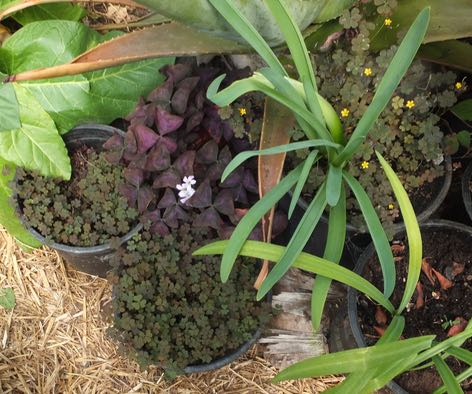
Now here’s a genus I promise you are going to grow at least one species of some day. You may already have one. A delightful purple leaved miniature clover like creeping plant, Yellow Oxalis, Oxalis corniculata. It’s one of the commonest of greenhouse weeds, which means it’s seldom thought desirable.
Okay, it does spread invasively by both runners and exploding seed pods and will take over almost anywhere. For Yellow Oxalis is one of the toughest survivors, immune to most pests and diseases, drought resistant, and low growing. And this all makes it an excellent ‘pot topper’ under taller specimens and likewise for ground cover in borders under cover.
Indeed you had better see it’s utility as I guarantee you will have it soon enough whether you want it or not. Yellow Oxalis arrives in the compost around plants and once in is admittedly hard to eradicate. I however find it so useful as I suggest especially as it’s in leaf and cheerful yellow flowers most of the year round.
Though you may, rightly, be doubtful as to O. corniculata you might find a similar, larger, species much more appealing. O. triangularis Purpurea, has similar much bigger wine purple patterned leaflets with whitish flowers. It’s every bit as easy as to soil and conditions and nearly as tough as Yellow Oxalis, it also makes excellent ground cover and is even suitable for a hanging basket.
In fact there are another two dozen or so Oxalis species from all over the World, all of which make good greenhouse specimens. The Bermuda Primrose, O. cernua, is actually from Africa and has the typical Oxalis foliage with yellow flowers up to an inch or more across. Other African species are O. bowieana with pink or lavender flowers, while O. hirta has purple flowers. O. oregana comes from the west coast of the USA where it is often sold as Irish Shamrock even though it has but three leaflets ! O. deppei from Mexico is sold as the Lucky Clover as it has the distinctive four leaflets (and an edible tuber). O. Hedysaroides rubra, the Firefern, comes from S. America, stands a metre or so tall with slender wiry stems sporting ferny leaves consisting of tiny satiny Oxalis leaflets of glorious wine red.
Finally, there is our wild Wood-sorrel, O. acetosella, hardy with beautiful purple veining to the white petals, this can be grown in the open, it was once eaten as a salad but this can no longer be recommended.


